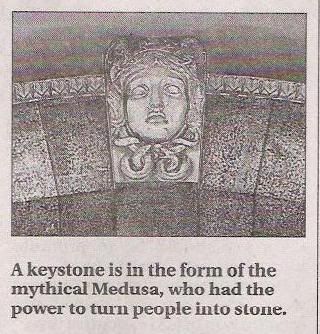G
GeorgeP
Guest

This file is too big to post so I'll just give the URL:
http://img.photobucket.com/albums/v232/ ... itoba1.jpg
That second image of Medusa, a cosmic joke of what goes around comes around

This file is too big to post so I'll just give the URL:
http://img.photobucket.com/albums/v232/ ... itoba1.jpg
In Veryan, Cornwall, there are some completely round houses.Locally we have the Stickney Mansion, which was built with no square corners, they are all rounded off. The family was into spiritualism and believed that 90 degree angles inhibited the flow of necessary energies. Link with photo: http://www.zuko.com/weird_n_spooky_america.htm#Stickney Mansion
In Veryan, Cornwall, there are some completely round houses.
"The village is probably best known for the five Round Houses built in the early 19th century for the Trist, each with thatched roofs and a cross on top; they stand two at either end of the village and one in the centre. They are often said to have been built round so that there was no corner for the Devil to hide and that the crosses on the roofs were intended to drive the Devil away but there is little or no evidence for this."
https://en.wikipedia.org/wiki/Veryan#Notable_buildings

In the 19th century Veryan's local vicar and land owner Jeremiah Trist expanded the village's buildings.[7] Aside from convincing his parishioners to attend church on a regular basis, he grew interested in property. He manned the building[clarification needed] of two schools and a series of five round houses. He was inspired to build the homes after one was built in St Winnow. Two of the round house cottages, "The Beehive" and "Left Round House", were built alongside one another on an entrance road to the village.[7] Trist installed crosses on each of the houses and they were said to deter the devil from entering the village.[8]
They bring to mind the Trullo houses of Apulia.
Bought one - on the back it says "Made in China".... is there anything not made there?
Irn Bru. It's made in Scotland from girders...... FACT!
Someone is selling H. P. Lovecrafts old apartment on Craigslist. That must count as occult architecture.
http://providence.craigslist.org/apa/5225929632.html

I've heard that it was originally a brewery
The Unicorn is now a tradename of Robinsons in Stockport. Their brewery is still named after it - so is one of their beers. I wonder if they acquired the name from an earlier firm?
I think it was also the name of the little bar which used to be in the wall beside the brewery gates. No excuse for the beer being stale there! Last time I passed, that little watering-hole was gentrified as an office or residence.
